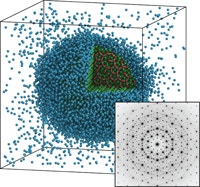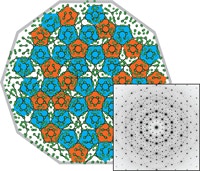MPS Awardee Spotlight: Sharon Glotzer

University of Michigan
Sharon Glotzer was appointed a Simons Investigator in Theoretical Physics as a member of the foundation’s inaugural class in 2012. She is the John W. Cahn Distinguished University Professor of Engineering and the Stuart W. Churchill Collegiate Professor of Chemical Engineering at the University of Michigan. Glotzer, who has broad research interests in materials science and soft matter physics, also holds the title of professor of materials science and engineering and professor of physics at the University of Michigan. She obtained her undergraduate degree at the University of California, Los Angeles and her Ph.D. at Boston University in theoretical condensed matter physics.
Glotzer is a member of the American Academy of Arts and Sciences and was elected to the National Academy of Sciences in 2014. She directs a research group that uses computer simulation to research fundamental problems involving statistical thermodynamics, applying their solutions to understand, for example, packing and assembly, and working to develop new ideas for such applications as materials design.
One of the many topics that Glotzer works on is nanoparticles and how they self-assemble. “I’m fascinated with patterns, and I’m especially obsessed with how patterns emerge from seemingly disordered systems,” says Glotzer. “Understanding the basic physics underlying spontaneous organization of matter — especially that driven by entropy maximization — may hold the key to new, pluripotent materials, cancer therapies, and even the origin of life itself.”

Isotropic particles (shown in red, green and blue) form a quasicrystalline solid with icosahedral symmetry that coexists with the gas phase. The central particles (green) align into rows and show ordered tiling (red with grey bonds)

Particles projected along a five-fold axis are arranged into a pentagonal Penrose tiling.
A key concept in Glotzer’s work is entropy, which is generally thought of as a measure of disorder in thermodynamic systems. However, she has found many examples of systems that order because of entropy. In her recent work, she has shown that complex structures can be formed using building blocks with simple shapes, such as the Platonic solids, that have no interactions between them. “Counterintuitively, they self-organize,” Glotzer tells us, “because of forces that are emergent when crowding occurs, and that are based on entropy.”
By exploiting entropy and its relation to information and dissipation, Glotzer hopes to push the boundaries of nanoparticles and the geometric patterns they form to design colloidal machines and information-rich, programmable structures.
Glotzer also investigates quasicrystals, which are crystals that to the eye look ordered, but in an unusual way, such as a Penrose tiling. Her group discovered in computer simulations that tetrahedra – the simplest Platonic solid – spontaneously arrange into a quasicrystal with 12-fold symmetry. Recently, her group was able to make a computer simulation of an icosahedral quasicrystal, using diffraction patterns to understand its structure. Glotzer says, “There are many experimentally found icosahedral quasicrystals, but before our work no one’s been able to self-assemble one with computer simulations. What’s more intriguing is that the forces are isotropic and not long-ranged — yet they produce a fully three-dimensional aperiodic pattern with no translational repeat unit — one of the most complex patterns known.”
This kind of theoretical work is useful since it can help guide new experiments that would try to understand how quasicrystals and other complex structures grow. Yet Glotzer’s motivation comes from a deep interest in complex problems and the challenge of solving them. “The reason I’m so interested in this result,” she says, “is because I think it’s the most complex structure that has ever been self-assembled in a computer simulation. How do the atoms know where to go?”


